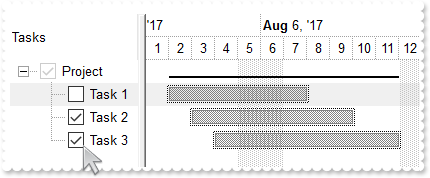A cell that contains a radio button or a check box button fires the CellStateChanged event when its state is changed. The control fires the CellStateChanging event just before cell's state is about to be changed. Use the CellState property to change the cell's state. Use the CellHasRadioButton or CellHasCheckBox property to enable radio or check box button into a cell. Use the Def property to assign check-boxes / radio-buttons for all cells in the column. Use the CellImage property to display an icon in the cell. Use the CellImages property to display multiple icons in the same cell. Use the PartialCheck property to enable partial check feature ( check boxes with three states: partial, checked and unchecked ). Use the CellChecked property to determine the handle of the cell that's checked in a radio group. Use the CellRadioGroup property to radio group cells.

Once the user clicks a check-box, radio-button, the control fires the following events:
-
CellStateChanging event, where the NewState parameter indicates the new state of the cell's checkbox / radio-button. You can change the NewState parameter during this event. For instance, NewState = Items.CellState(Item,ColIndex) un-changes the cell's state once the user tries to change it.
-
CellStateChanged event notifies your application that the cell's check-box or radio-button has been changed. The CellState property determines the check-box/radio-button state of the cell.
private void CellStateChanged(object sender,int Item,int ColIndex)
{
}
Private Sub CellStateChanged(ByVal sender As System.Object,ByVal Item As Integer,ByVal ColIndex As Integer) Handles CellStateChanged End Sub |
Syntax for CellStateChanged event, /COM version, on:
private void CellStateChanged(object sender, AxEXG2ANTTLib._IG2anttEvents_CellStateChangedEvent e)
{
}
void OnCellStateChanged(long Item,long ColIndex)
{
}
void __fastcall CellStateChanged(TObject *Sender,Exg2anttlib_tlb::HITEM Item,long ColIndex)
{
}
procedure CellStateChanged(ASender: TObject; Item : HITEM;ColIndex : Integer); begin end; procedure CellStateChanged(sender: System.Object; e: AxEXG2ANTTLib._IG2anttEvents_CellStateChangedEvent); begin end; begin event CellStateChanged(long Item,long ColIndex) end event CellStateChanged Private Sub CellStateChanged(ByVal sender As System.Object, ByVal e As AxEXG2ANTTLib._IG2anttEvents_CellStateChangedEvent) Handles CellStateChanged End Sub Private Sub CellStateChanged(ByVal Item As EXG2ANTTLibCtl.HITEM,ByVal ColIndex As Long) End Sub Private Sub CellStateChanged(ByVal Item As Long,ByVal ColIndex As Long) End Sub LPARAMETERS Item,ColIndex PROCEDURE OnCellStateChanged(oG2antt,Item,ColIndex) RETURN |
Syntax for CellStateChanged event, /COM version (others), on:
<SCRIPT EVENT="CellStateChanged(Item,ColIndex)" LANGUAGE="JScript"> </SCRIPT> <SCRIPT LANGUAGE="VBScript"> Function CellStateChanged(Item,ColIndex) End Function </SCRIPT> Procedure OnComCellStateChanged HITEM llItem Integer llColIndex Forward Send OnComCellStateChanged llItem llColIndex End_Procedure METHOD OCX_CellStateChanged(Item,ColIndex) CLASS MainDialog RETURN NIL void onEvent_CellStateChanged(int _Item,int _ColIndex)
{
}
function CellStateChanged as v (Item as OLE::Exontrol.G2antt.1::HITEM,ColIndex as N) end function function nativeObject_CellStateChanged(Item,ColIndex) return |
The following VB sample displays a message when the user clicks a check box or a radio button:
Private Sub G2antt1_CellStateChanged(ByVal Item As EXG2ANTTLibCtl.HITEM, ByVal ColIndex As Long) Debug.Print "The cell """ & G2antt1.Items.CellValue(Item, ColIndex) & """ has changed its state. The new state is " & IIf(G2antt1.Items.CellState(Item, ColIndes) = 0, "Unchecked", "Checked") End Sub
The following VC sample displays the caption of the cell whose checkbox's state is changed:
#include "Items.h"
static CString V2S( VARIANT* pv, LPCTSTR szDefault = _T("") )
{
if ( pv )
{
if ( pv->vt == VT_ERROR )
return szDefault;
COleVariant vt;
vt.ChangeType( VT_BSTR, pv );
return V_BSTR( &vt );
}
return szDefault;
}
void OnCellStateChangedG2antt1(long Item, long ColIndex)
{
CItems items = m_g2antt.GetItems();
COleVariant vtItem( Item ), vtColumn( ColIndex );
CString strCellValue = V2S( &items.GetCellValue( vtItem, vtColumn ) );
CString strOutput;
strOutput.Format( "'%s''s checkbox state is %i\r\n", strCellValue, items.GetCellState( vtItem, vtColumn ) );
OutputDebugString( strOutput );
}
The following VB.NET sample displays a message when the user clicks a check box or a radio button:
Private Sub AxG2antt1_CellStateChanged(ByVal sender As Object, ByVal e As AxEXG2ANTTLib._IG2anttEvents_CellStateChangedEvent) Handles AxG2antt1.CellStateChanged
Debug.WriteLine("The cell """ & AxG2antt1.Items.CellValue(e.item, e.colIndex) & """ has changed its state. The new state is " & IIf(AxG2antt1.Items.CellState(e.item, e.colIndex) = 0, "Unchecked", "Checked"))
End Sub
The following C# sample outputs a message when the user clicks a check box or a radio button:
private void axG2antt1_CellStateChanged(object sender, AxEXG2ANTTLib._IG2anttEvents_CellStateChangedEvent e)
{
string strOutput = axG2antt1.Items.get_CellValue( e.item, e.colIndex ).ToString();
strOutput += " state = " + axG2antt1.Items.get_CellState(e.item, e.colIndex).ToString() ;
System.Diagnostics.Debug.WriteLine( strOutput );
}
The following VFP sample prints a message when the user clicks a check box or a radio button:
*** ActiveX Control Event *** LPARAMETERS item, colindex local sOutput sOutput = "" with thisform.G2antt1.Items .DefaultItem = item sOutput = .CellValue( 0, colindex ) sOutput = sOutput + ", state = " + str(.CellState( 0, colindex )) wait window nowait sOutput endwith

